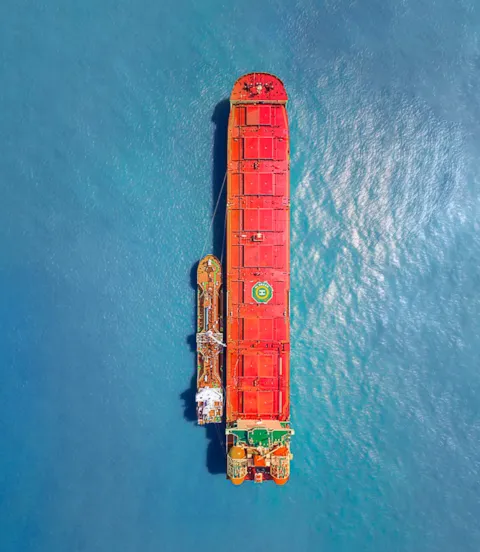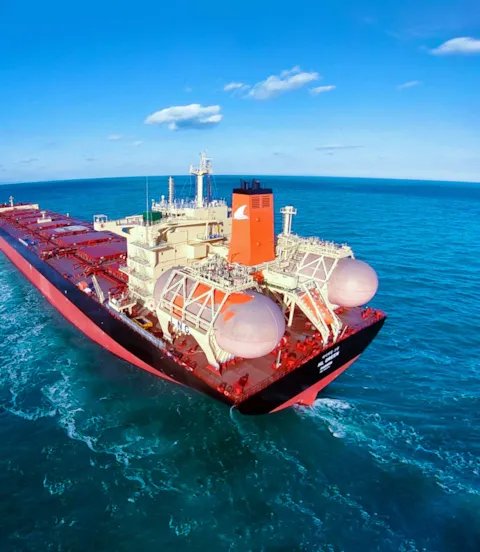H-Line and DNV open doors to Korean LNG fuel market
DNV has awarded its gas-fuelled notation to two LNG dual-fuel (DF) bulk carriers built at Hyundai Samho Heavy Industries (HSHI) for Seoul-based H-Line Shipping. The Capesize ships will be the first large LNG-fuelled vessels to trade internationally from Korea.

First Korean marine LNG tanks
The vessels’ LNG fuel tanks each have a storage capacity of 1,600 m3, the largest LNG fuel tanks currently applied for a bulk carrier. Notably, the fuel tanks and hulls are constructed entirely of domestically produced steel.
“For stable material supplies and market expansion, HSHI and steel-making company POSCO worked closely together and succeeded in applying domestically produced steel with nine per cent nickel for the LNG tanks, enhancing the quality of the material to meet the International Maritime Organization’s (IMO) tightening standards,” explains Kyung Shin Yoon, Senior Engineer at HSHI Design Coordination. The nickel/steel blend had been previously used only for land-based LNG storage facilities in Korea.

Broad technical and design cooperation
“Throughout the design approval and construction stages, there were new challenges to be met due to these vessels being the world’s first ocean-going dual-fuel bulkers with LNG tanks of this size,” says HSHI’s Yoon. “We are thankful for the support from DNV during the classification of the tanks and the practical assistance offered to HSHI to ensure an efficient design and construction process.”
In one notable case, HSHI faced challenges in arranging a separate cofferdam area between the LNG tanks and the engine room compartments. The cofferdam arrangement was expected to lead to various cost and schedule impacts for material input, space loss and productivity.
“DNV’s interpretation and optimized alternative allowed us to keep the as-built structural arrangement without a cofferdam, and to minimize the additional specifications,” Yoon reports. “We are especially grateful to DNV for their broad technical support and collaborative attitude.”

LNG development for Korea and Asia
The H-Line project marks a breakthrough not only for LNG as ship fuel in the bulk sector, but for LNG in the entire Asia-Pacific region. According to DNV’s Alternative Fuels Insight (AFI) portal, the number of confirmed LNG terminals and hubs is now rising quickly as the LNG-fuelled fleet grows. AFI currently indicates 54 LNG-fuelled vessels operating in Asia-Pacific, with 17 bunker ships either in operation or awaiting delivery.
Among regional LNG developments, South Korea has revised legislation governing the development of its urban gas business to include LNG for vessel use, as part of an effort to promote its domestic LNG bunkering sector. The LNG bunkering infrastructure will be further expanded to ensure robust and competitive supplies, including the Busan port.
In addition, the Australian government now offers a 50 per cent discount in port dues to bulk vessels bunkering with LNG at the Port of Pilbara, while Singapore continues to add LNG bunkering vessels to its ports, and Petronas has announced plans to expand LNG bunkering facilities to keep up with demand in South East Asia.

H-Line ships mark LNG milestones
“We have built the largest number and varieties of ships operating on LNG among Korean shipyards,” says Hyung Kwan Kim, CEO of HSHI. “Building on these pioneering successes, we will strive to provide a clear incentive for more shipowners to opt for LNG-fuelled ships as a measure to meet the IMO 2020 regulation requirements.”
“LNG is a key element in reaching the IMO 2030 emissions reduction goals, and this project will serve to promote the use of LNG as a maritime fuel in Korea and in the region,” says Gil Su Kim, Key Account Manager, Maritime at DNV. “We are very pleased to support H-Line in their work to reduce emissions, and to help facilitate broad industry collaboration on the use of marine LNG in Korea.”
- H-Line
- Peninsula Petroleum
- Credit H-Line
- Credit Peninsula Petroleum
